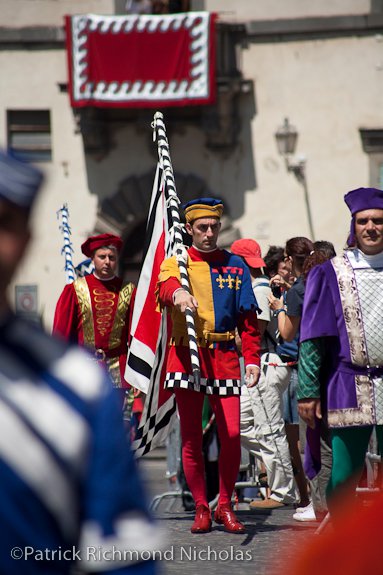Colours are the most striking element of the Pageant of Orvieto, and not only for the polychromatic beauty and harmony of tones, but also for the symbolic value that it takes.
 The different colours were used, in men’s and women’s clothes, to define a sentimental, family or even social or political belonging: from the knights who wore as a tribute the colours of the beloved, to those who wore the colours of their family as a distinctive sign, or the colours of another family as a declaration of submission to a Lord of or even sported in honour of a noble stranger arrived in town.
The different colours were used, in men’s and women’s clothes, to define a sentimental, family or even social or political belonging: from the knights who wore as a tribute the colours of the beloved, to those who wore the colours of their family as a distinctive sign, or the colours of another family as a declaration of submission to a Lord of or even sported in honour of a noble stranger arrived in town.
The combinations and meaning became more and more complicated, this is the reason why the colour symbolism was just a fashion game in the Italian Renaissance courts.
In the fourteenth century and the first half of the fifteenth century, the use of bright colours, often combined with contrasting various forms of bipartite arrangement in a vertical chessboard, stripe and wave layouts, is particularly common.
Varlets, trumpeters and candle bearers stand out in the pageant because of the vibrant bipartite colours.
The most assessed colour is by far the scarlet red – colour used par excellence for the regal and noble mantles, for the covers of the magistrates and in some cases of doctors – followed by deep green, often coupled in contrast.
The pinkish purple, the scarlet, the violet, the peacock blue, the poppy red, the Alexandrian (dark blue-turquoise) and blue-azure (our sky-blue) were also very appreciated.
The gray, with all its variations, and shades of dull brown, were instead the colours of craftsmen, while the populace – farmers, masons, workers in general – dressed in white.
Even the black was an important colour because it designated a social type of nobility or authority, although it was generally placed before the red mainly because it was imposed by all health laws enacted, since it was a much less expensive tint; it symbolically denoted firmness, authority, perseverance, steadfastness of purpose.
The most striking example of the use of black in the Pageant of Orvieto is the mantle worn by the First Knight, embroidered in white, red, gold and silver silk.
